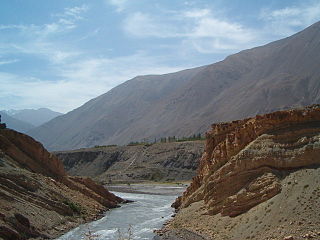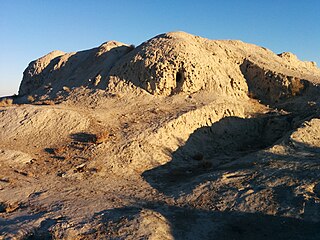
The Amu Darya, also shortened to Amu and historically known as the Oxus, is a major river in Central Asia, which flows through Tajikistan, Turkmenistan, Uzbekistan and Afghanistan. Rising in the Pamir Mountains, north of the Hindu Kush, the Amu Darya is formed by the confluence of the Vakhsh and Panj rivers, in the Tigrovaya Balka Nature Reserve on the border between Afghanistan and Tajikistan, and flows from there north-westwards into the southern remnants of the Aral Sea. In its upper course, the river forms part of Afghanistan's northern border with Tajikistan, Uzbekistan, and Turkmenistan. In ancient history, the river was regarded as the boundary of Greater Iran with Turan, which roughly corresponded to present-day Central Asia. The Amu Darya has a flow of about 70 cubic kilometres per year on average.

The Syr DaryaSEER-DAR-yə, historically known as the Jaxartes, is a river in Central Asia. The name, which is Persian, literally means Syr Sea or Syr River. It originates in the Tian Shan Mountains in Kyrgyzstan and eastern Uzbekistan and flows for 2,256.25 kilometres (1,401.97 mi) west and north-west through Uzbekistan, Sughd province of Tajikistan, and southern Kazakhstan to the northern remnants of the Aral Sea. It is the northern and eastern of the two main rivers in the endorheic basin of the Aral Sea, the other being the Amu Darya.

Merv, also known as the Merve Oasis, was a major Iranian city in Central Asia, on the historical Silk Road, near today's Mary, Turkmenistan. Human settlements on the site of Merv existed from the 3rd millennium BC until the 18th century AD. It changed hands repeatedly throughout history. Under the Achaemenid Empire, it was the center of the satrapy of Margiana. It was subsequently ruled by Hellenistic Kings, Parthians, Sasanians, Arabs, Ghaznavids, Seljuqs, Khwarazmians and Timurids, among others.

The Bactria–Margiana Archaeological Complex (BMAC) is the modern archaeological designation for a particular Middle Bronze Age civilisation of southern Central Asia, also known as the Oxus Civilization. The civilisation's urban phase or Integration Era, was dated in 2010 by Sandro Salvatori to c. 2400–1950 BC, but a different view is held by Nadezhda A. Dubova and Bertille Lyonnet, c. 2250–1700 BC.

Türkmenabat, formerly Amul, Cärjew/Chardzhou, and Novy Chardzhuy, is the second-largest city in Turkmenistan and the administrative centre of Lebap Province. As of 2009, it had a population of approximately 254,000 people. From 1924 to 1927, it was also named Leninsk in honor of Vladimir Lenin.

The Zarafshon is a river in Tajikistan and Uzbekistan in Central Asia. Its name, "spreader of gold" in Persian, refers to the presence of gold-bearing sands in the upper reaches of the river. To the ancient Greeks it was known as the Polytimetus. It was also formerly known as Sughd River. The river is 877 kilometres (545 mi) long and has a basin area of 17,700 square kilometres (6,800 sq mi).

Termez is the capital of Surxondaryo Region in southern Uzbekistan. Administratively, it is a district-level city. Its population is 182,800 (2021). It is notable as the site of Alexander the Great's city Alexandria on the Oxus, as a center of early Buddhism, as a site of Muslim pilgrimage, and as a base of Soviet Union military operations in Afghanistan, accessible via the nearby Hairatan border crossing.

Shahrisabz is a district-level city in Qashqadaryo Region in southern Uzbekistan. The Economic Cooperation Organization (ECO) has selected Shakhrisabz as its tourism capital for 2024.

Dalverzin Tepe is an ancient archaeological site founded by the Graeco-Bactrian Kingdom and located near to the modern city of Denau in the Surxondaryo Region of Uzbekistan. The city was founded in the 3rd century BC and rose to prominence in the Kushan period when two important Buddhist temples were built here. Dalverzin Tepe was excavated by the famed Soviet archeologist Galina Pugachenkova.

Khalchayan is an archaeological site, thought to be a small palace or a reception hall, located near the modern town of Denov in Surxondaryo Region of southern Uzbekistan. It is located in the valley of the Surkhan Darya, a northern tributary of the Oxus.

Paykend or Poykent, an ancient city in Uzbekistan, is located in the lower stream of Zarafshan River and was one of the largest cities of the Bukhara oasis. The city consisted of a citadel, two settlements, and a rabod (suburb). Paykend is currently under consideration for inscription as a UNESCO World Heritage site.
Shahrukhiya is a site of ancient settlement located 88 km to the southwest of Tashkent, Uzbekistan, on the right coast of Syrdarya River. It is the first large city of the Tashkent oases, situated on the Great Silk Road through Yaksart (Syrdarya). In the oriental sources, it was famous under the name Benaket, and the portion of the Great Silk Road direction called by its name.
The site of ancient settlement at Kanka, Uzbekistan, is located in 80 km southwest of Tashkent, in the southeastern outskirts of the Eltamgali settlement. It is one of the large, ancient city centers of the Tashkent oasis. Kanka is the first capital of the Chach state, a small estate of Kanguy.
Gurlan is a town and seat of Gurlan District in Xorazm Region in Uzbekistan. It is located near the border with Turkmenistan in western Uzbekistan, 42 kilometres (26 mi) north-west of Urgench, north of Shovot, and south of the Amu Darya river. Gurlen is a major centre for cotton production, and rice and yams are also significant other crops.
The history of Bukhara stretches back millennia. The origin of its inhabitants goes back to the period of Aryan immigration into the region. The city itself, currently the capital of the Bukhara Region (viloyat) of Uzbekistan, is about two and a half thousand years old. Located on the Silk Road, the city has long been a centre of trade, scholarship, culture, and religion. During the Golden age of Islam, under the rule of Samanids, Bukhara became the intellectual centre of the Islamic world. In medieval times, Bukhara served as the capital of the Khanate of Bukhara and was the birthplace of Imam Bukhari.

The Syr-Darya Oblast was one of the oblasts of the Russian Empire, a part of Russian Turkestan. Its center was Tashkent.

Aqcha or Akcha, is a city in northern Afghanistan. It is located approximately 50 kilometres (31 mi) east of Sheberghan and 100 kilometres (62 mi) west of Mazar-i-Sharif. It serves as the center of the Aqcha District of Afghanistan's Jowzjan Province. The town is situated a few kilometers north of the main Sheberghan-Mazar-i-Sharif road called Aqyol.

Varakhsha, also Varasha or Varahsha, was an ancient city in the Bukhara oasis in Sogdia, founded in the 1st century BCE. It is located 39 kilometers to the northwest of Bukhara. Varakhsha was the capital of the Sogdian dynasty of the kings of Bukhara, the Bukhar Khudahs. It ultimately never recovered from the Muslim conquest of Transoxiana. After British archaeologists began investigating the site in the 1820s, it became "the very first Sogdian archaeological site mentioned in European literature."
Kampir Tepe is an archaeological site located within the Surxondaryo Region of Uzbekistan, near the village Shoʻrob, northwest of the city of Termez. It is thought to be the lost city of Alexandria on the Oxus described by Ptolemy, though the Amu Darya river has now changed its course. The Telegraph newspaper describes Kampir Tepe as “the Pompeii of Central Asia.”

Tudakul lake, Tudakul reservoir, or simply Tudakul is located in the Qiziltepa district of Navoiy region. It was formed in 1952 due to the subsidence of the Zarafshan River waters into the Tudakul depression, naturally occurring as a result. Situated about 26 kilometers east of Bukhara in a natural depression, it's positioned in the eastern part of the Quyimozor Water Reservoir. This water basin was converted into a water reservoir in 1968.


















